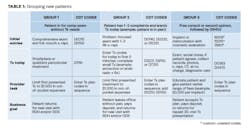New patients: Saving time and making a great first impression
New patients are an essential part of any dental practice. They are the lifeblood of the practice and the ones who keep the practice running. New patients represent an opportunity for dental practices to grow and expand their patient base.
When new patients have a positive experience at the dental practice, they are more likely to recommend it to their friends and family. This can help improve the practice’s reputation in the community. Alternatively, if new patients have a negative experience, they are likely to share those experiences with others, which can harm the reputation of the practice.
Screening and scheduling new dental patients
My practice has a system for screening and scheduling new dental patients. This helps us treat new patients in a more organized and time-efficient way, and it increases the probability of new patients becoming returning patients.
When we receive initial patient contact via phone calls or online requests, we divide those patients into three groups (table 1):
- Group 1: Those seeking comprehen-sive exams, x-rays, and cleanings
- Group 2: Those experiencing pain, discomfort, or need immediate help
- Group 3: Those seeking consultations, second opinions, or consider-ing treatments like cosmetic pro-cedures, orthodontics/Invisalign, or dental implants. Initial visits for group 3 patients can often be complimentary.
Initial appointments for the three groups of patients are planned differently because their expectations and goals vary—and the CDT codes we use will also depend on the situation. Our goal is to keep new-patient appointments efficient, so we have a clinical notes template attached to each code. By the end of the patient appointment, all codes have been entered and clinical notes are completed.
Over the years our practice has consistently achieved an 80%–83% new-patient return rate. By focusing on these three classifications of patients, dental practices can attract new patients, treat them efficiently, and retain them to build a successful practice.
Group 1 patients
Typical group 1 patients may be new to the area, desire an “exam and cleaning,” and have no other treatment needs. We schedule these patients with a hygienist or dentist for 60–75 minutes. A full series of x-rays, intraoral scan, comprehensive exam, and oral cancer screening are completed.
If the patient needs a regular six-month prophylaxis, we complete it during the same visit. If the patient needs periodontal scaling/deep cleaning, then scaling of a quadrant or of a few teeth will be performed. If a patient needs more extensive restorative dentistry or other treatment, we propose to schedule it in smaller increments so as not to overwhelm the patient; we will continue treatment at future visits.
Our rule is to limit proposed treatment to group 1 patients and postpone nonemergency treatment to the next visit. Our goal with the group 1 patient’s initial visit—-besides an “exam and cleaning”—is to make a good first impression, establish rapport, schedule small treatment for the next visit, and allow time for further presentation of the treatment plan.
Group 2 patients
Group 2 patients are the ones who are experiencing pain, discomfort, a broken tooth, loose crown, or an abscess, and who need immediate treatment. We schedule these patients with the dentist for no less than 60 minutes. To clarify the reason for the appointment, we may set up a 15-minute virtual appointment in advance to determine the scope of the upcoming visit and to premedicate the patient if necessary.
The following procedures can be completed: problem-focused exam, x-rays, extraction, bone graft, pulpal debridement, incision and drainage, sedative or permanent restoration, crown recementation of a new crown.
The primary goal of the initial visit for a group 2 patient is alleviation of pain, followed by scheduling nonemergency treatments. The appointment is typically secured with a deposit.
Group 3 patients
Group 3 patients look for a consultation or a second opinion for one of the following reasons: cosmetic treatment, complex full-arch or full-mouth restorations, dental implant treatment, treatment under sedation, and Invisalign treatment. These patients can be offered a complimentary visit. We schedule the group 3 patient with the dentist for 30-45 minutes.
During the first 15 minutes of the appointment, the assistant takes extra- and intraoral photographs, an intraoral scan, shows the patient a short video related to the proposed treatment (using the Consult Pro platform), and takes 3D images if implant treatment is to be discussed.
We have three custom CDT codes we use for these exams: implant consultation, cosmetic consultation, and malocclusion/Invisalign consultation. Each of these codes comes with a custom template for the dentist to fill out during the first few minutes of the initial exam.
After the images are uploaded, the patient is invited to the consultation room where we have patient education leaflets, models, and portfolio photos of similar before-and-after cases. We always try to give patients two or three restorative options so they can feel free to make their own treatment choices.
The goal of the group 3 patient initial visit is to gain patient trust, present treatment options, let patients make their own choices, and schedule the next appointment with confidence. The end goal is to instill trust, present varied treatment paths, and secure future appointments—sometimes underpinned with a deposit.
Editor's note: This article appeared in the April 2024 print edition of Dental Economics magazine. Dentists in North America are eligible for a complimentary print subscription. Sign up here.
Alex Osinovsky, DDS, DICOI, graduated from the University of Maryland Dental School in 1998 and currently leads a multispecialty group dental practice in Vienna, Virginia. His primary passions are implant dentistry, digital dentistry, and practice management. Contact him at [email protected] or call (703) 848-8906.
About the Author

Alex Osinovsky, DDS, DICOI
Alex Osinovsky, DDS, DICOI, graduated from the University of Maryland Dental School in 1998 and currently leads a multispecialty group dental practice in Vienna, Virginia. His primary passions are implant dentistry, digital dentistry, and practice management. Contact him at [email protected] or call (703) 848-8906.
Updated February 28, 2024



